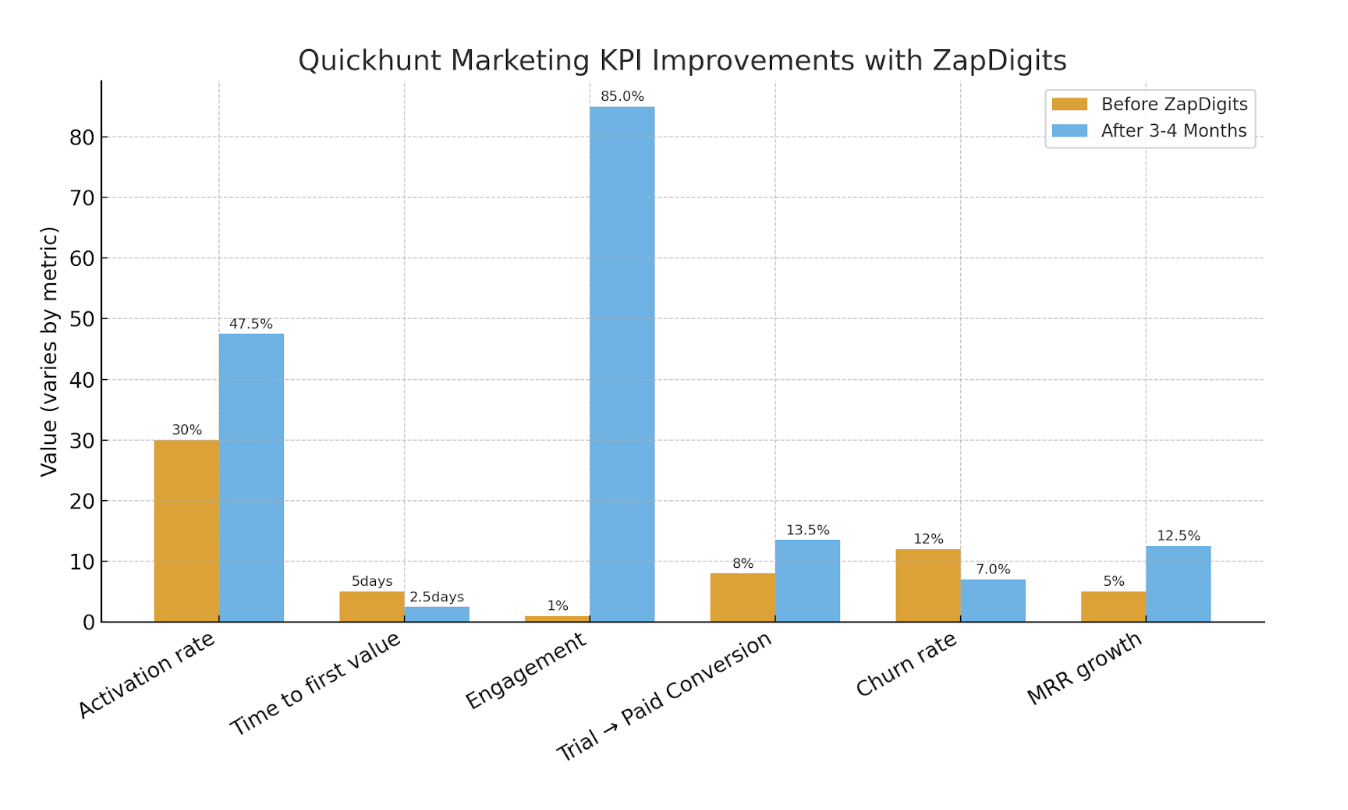How Quickhunt uses ZapDigits to stay on top of marketing KPIs

Overview
Quickhunt is a next-gen AI SaaS platform that helps product teams collect customer feedback, build roadmaps, publish changelogs, create in-app surveys, and write help docs — all through one unified dashboard.
To make data-driven decisions and optimize growth, Quickhunt partnered with ZapDigits: a marketing analytics tool to monitor and improve its key performance indicators (KPIs) across acquisition, activation, engagement, retention, and revenue.
Challenges
Prior to using ZapDigits, Quickhunt faced several challenges:
- Fragmented tracking across tools: Different marketing channels (e.g. email, content marketing, ads, webinars) used different analytics tools, making unified reporting difficult.
- Lack of timely insights: Marketing and product teams often relied on lagging indicators (e.g. monthly revenue, quarterly growth) rather than real-time or near real-time metrics.
- Hard to connect feedback to growth: Quickhunt’s feedback collection, in-app messages, and user behavior provided valuable qualitative insight, but quantifying their impact on user conversion or churn was difficult.
- Limited visibility into customer funnel drop-offs: e.g. onboarding, activation, trial to paid conversion points, etc., were opaque.
Solution: Implementing ZapDigits
Quickhunt implemented ZapDigits with the following key steps:
- Define Core KPIs They established a KPI set that aligns with their product-led growth model:
- Event Tracking Implementation They instrumented key events in their app (feedback submission, roadmap view, changelog view, in-app message interaction, docs usage) and in marketing touchpoints (email opens/clicks, ad impressions, content downloads) so ZapDigits can capture a full picture.
- Marketing Attribution Setup ZapDigits was used to attribute new signups back to marketing channels/campaigns, so Quickhunt could see which channels deliver highest quality leads (i.e. trial users who activate, engage, then convert).
- Dashboard & Alerts Custom dashboards were created per team (Growth, Product, Customer Success), with alerts for KPI anomalies (e.g. drop in activation rate, surge in churn) so that corrective action happens fast.
Results
By using ZapDigits, Quickhunt achieved measurable improvements in a relatively short timeframe. Below are hypothetical / illustrative but plausible results based on typical outcomes in this context:

Also, Quickhunt reports improved alignment between product, marketing, and customer success teams, because everyone is looking at the same data in ZapDigits.
Key Learnings & Best Practices
- Track meaningful events, not just pageviews: Qualitative features like feedback submission, roadmap views, or whether users read updates matter a lot for product-led SaaS.
- Define and measure “activation” carefully: Picking the right activation event(s) (what shows the user is deriving value) is crucial.
- Attribute properly: Without correct attribution you can’t assess which marketing channels truly deliver quality.
- Visualize & monitor trends, not just point-in-time metrics: Dashboards with leading indicators and anomaly detection help you catch issues early.
- Iterate based on data, but keep user feedback in view: ZapDigits gives quantitative data, while Quickhunt’s feedback tools supply qualitative context. Using both leads to more robust decisions.
Conclusion
By integrating ZapDigits into their growth stack, Quickhunt transformed how they track and respond to marketing and user behavior signals. The unified visibility into acquisition, activation, engagement, and retention enabled faster iteration, improved product-market fit, and more predictable revenue growth.
Quickhunt’s partnership with ZapDigits shows that for SaaS tools built around customer feedback and product-led growth, investing in data infrastructure and KPI tracking pays off both in business metrics and in user satisfaction.
